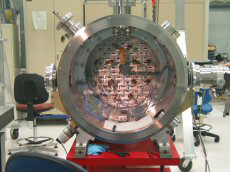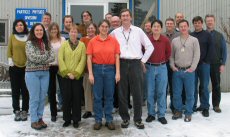Dark energy, say 'cheese'

With over 100 times the resolution of an average digital camera, this giant contraption would take detailed photos of the night sky.
Most people these days want tiny, lightweight digital cameras that slide into their wallets alongside their credit cards. But what if you want to take a picture of something really big? Like, say, the universe? You might just need a really big camera.
Fermilab astrophysicists and their collaborators from the Dark Energy Survey have spent the last three years developing the largest digital camera in the world. The camera stands over a half meter in diameter and will be installed onto the 4-meter Blanco Telescope at the Cerro Tololo Inter-American Observatory in Chile. Its 520 megapixels, large size and ultra-sensitive silicon detectors will help the collaboration search the night sky for evidence of the bizarre stuff that makes up over two-thirds of the universe: dark energy.
Although dark energy might account for the universe's puzzling, accelerating expansion, its physical properties remain a mystery. Dark Energy Survey physicists will use the giant camera to observe dark energy in four different ways: through supernova distances, light lensing, and both structure and timing of galaxy clustering. "If we used just one technology, we'd have systematic problems," said Brenna Flaugher, the lead scientist for the camera construction project. The four techniques will allow scientists to cross-check their results.
The hard part, however, is creating a really big camera. The key to the camera's performance is a series of 62 silicon sensors, or charge-coupled devices (CCDs). After careful assembly at SiDet, Juan Estrada, co-manager with Tom Diehl of the focal plane detector, tests each charge-coupled device individually with different wavelengths of light. After these rigorous tests, only about 25 percent of the individual devices conform to the quality standards; the rest are rejected. "We want to understand how they will perform under different optical conditions in the telescope," Estrada said. The sensors are sensitive to longer light wavelengths than any previous optical camera, allowing scientists to get deeper in the sky without using long exposure times.
Though it is still in the R&D phase, the proposed camera could begin observations as soon as 2010, and run for 5 years. Researchers hope that's long enough to find the photogenic side of dark energy.
--Christine Buckley

Some of the approximately 100 members of the Dark Energy Survey collaboration say "cheese" in front of the SiDet building.
|